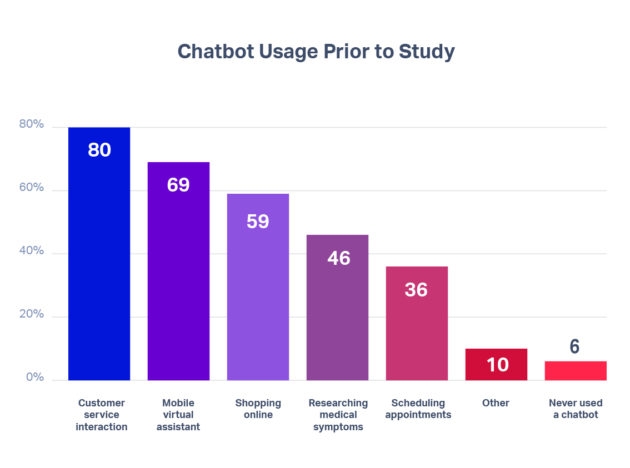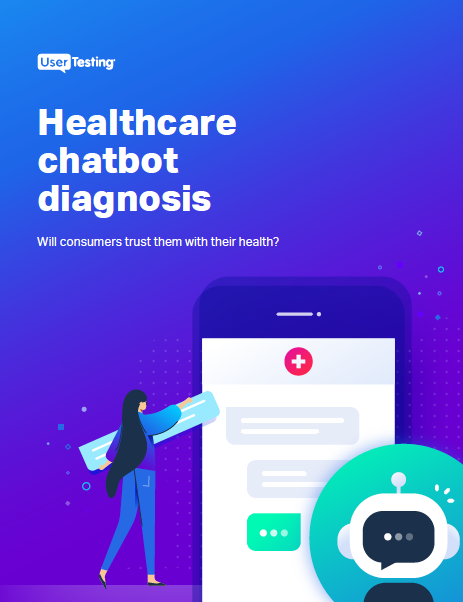
Healthcare chatbot diagnosis: will consumers trust them with their health?

Technology has transformed many things in our day-to-day lives. Just about anything can be accessed via a computer or app—including health and wellness resources.
As consumers become more comfortable digitally sharing their personal information, accessing medical advice or information via an app may soon become the new normal. Yet, even as consumers warm up to conversational AI platforms, like chatbots, early adoption doesn’t absolve these types of platforms from providing the same level of experience consumers have come to expect from other best-in-class digital experiences.
With 45% of Millennials foregoing a primary care physician and consumers opting for more on-demand style care, the healthcare industry has taken notice. According to HIMSS Analytics, healthcare providers offering options like chatbots has risen to over 71% in recent years.
To gauge consumers’ satisfaction with the experience of getting a medical diagnosis via a healthcare chatbot, UserTesting conducted a competitive benchmarking study, Healthcare chatbot diagnosis: will consumers trust them with their health? to evaluate five healthcare chatbot apps, Ada, Mediktor, Your.MD, Symptomate, and HealthTap. Five hundred participants were given a list of symptoms for the common cold, and for food poisoning, and were asked to use the apps to get a diagnosis. Consumers then evaluated the apps based on five factors—Ease of use, Speed, Credibility, Aesthetics, and Delight.
The study uncovered three key findings:
- Chatbot apps do a poor job of handling complex conditions
- Chatbot apps still need to earn consumer trust
- Basic usability issues detracted from the experience
Complex conditions need a check-up
When it came to simple conditions, like a cold or the flu, most of the apps were able to produce a satisfactory diagnosis or recommendation for treatment.
More complex conditions, however, left much to be desired. All the apps we looked at suffered a drastic decrease in scores when participants attempted to diagnose more complex symptoms, like those of food poisoning.
Participants noted that diagnoses ranged from overly general and thus, unhelpful, to wildly alarming.
There is a big difference between acute gastroenteritis and heart failure. - Female, 34 years old
Consumer trust needs a second opinion
Although consumers are more willing than ever to share their information via social networks, when it comes to their health, they were understandably a bit more guarded. The apps’ lack of acknowledgment of compliance with HIPAA (Health Insurance Portability and Accountability Act of 1996) combined with general usability issues and lack of brand recognition left participants wary of trusting the apps with their health.
I don’t know what the credentials are, or how long this app had been around, so not sure of its trustworthiness. - Female, 49 years old
Basic usability issues abound
Although healthcare chatbot apps may be in their infancy, consumers expectations for a seamless experience were still high. In fact, the study revealed that despite participants’ unfamiliarity with the apps tested, 94% had prior experience with chatbot apps, 46% of whom used them to research medical symptoms.

Healthcare chatbots have potential—and a long way to go to earn consumer trust
The healthcare industry is on the verge of change, with both consumers and providers anticipating solutions to meet their ever-changing needs and high expectations. As with any experience, tapping into human insights at every stage of development is critical. As our study revealed, consumers welcomed the idea of healthcare chatbots but stopped short of committing to actually using them.
These apps and others in their space are in a great position to immediately start infusing customer insights into every decision they make. The difference between those that succeed and those that fail will be the reliance on human insight—those that succeed will better understand their customers because they’re incorporating human insight into every experience they deliver.
Want to learn more?
You can download the full report here. If you’d like to learn how UserTesting can help you understand your customers through on-demand human insights, contact us here.
In this Article

Learn how consumer healthcare needs and habits are evolving, and how the the the healthcare industry can better meet their needs.
Learn how consumer healthcare needs and habits are evolving, and how the the the healthcare industry can better meet their needs.


